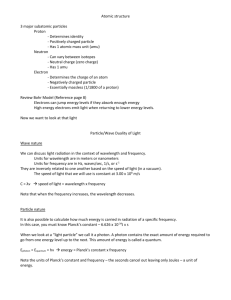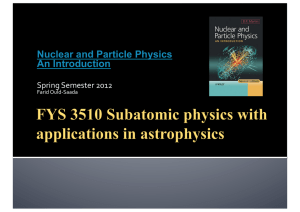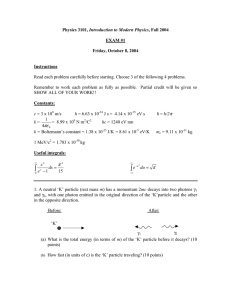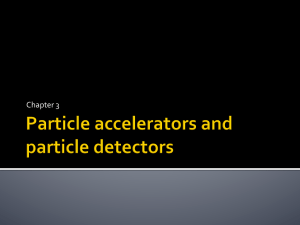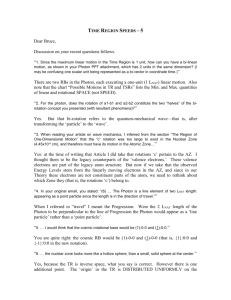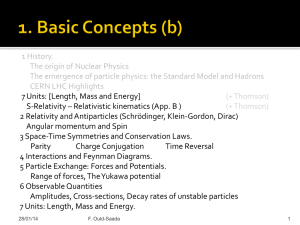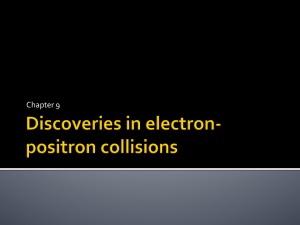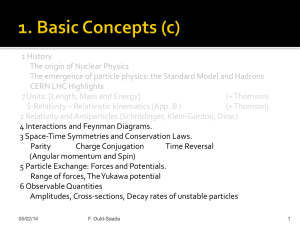Chapter 2
advertisement
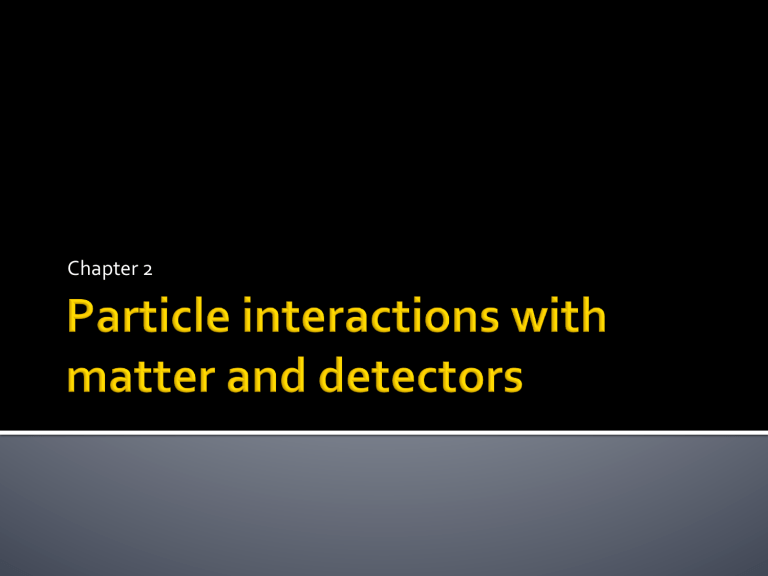
Chapter 2 ¡ ¡ ¡ ¡ ¡ ¡ ¡ ¡ 2.1 Introduction 2.2 Passage of Charged Particles Through Matter § § 2.2.1 Energy Loss Through Ionization and Excitation 2.2.2 “Classical” Calculation of Energy Loss Through Ionization § § § 2.3.1 Photoelectric Effect 2.3.2 Compton Scattering 2.3.3 Pair Production 2.2.3 Bremsstrahlung 2.3 Photon Interactions 2.4 Electromagnetic Showers 2.5 Neutron Interactions 2.6 Qualitative Meaning of a Total Cross-Section Measurement 2.7 Techniques of Particle Detection § ¡ ¡ ¡ ¡ ¡ ¡ 2.7.1 General Characteristics 2.8 Ionization Detectors 2.9 Scintillation Counters 2.10 Semiconductor Detectors 2.11 Cherenkov Counters 2.12 The Bubble Chamber 2.13 Electromagnetic and Hadronic Calorimeters 31/01/16 F. Ould-Saada Only Briefly - Read book for further details - More in followup course FYS4550 2 ¡ To see a particle? § To observe object is to detect light reflected by its surface ▪ Light is a component of EM radiation detectable by eye (400nm-700nm) § Particle detector is a translator that connects a sensory organ (or computer) with the effect produced by the interaction of the particle with matter ▪ through adequate amplifications and processing ¡ Objective: study § main processes of interaction of radiation with matter § and related experimental detection techniques ¡ Radiation (E> keV) § Charged – electron, proton, … § Neutral – photon, neutron, … § Radiation interacts with / “see” matter (electrons, atomic nuclei, nucleons, quarks, …) ¡ Particle detectors based on Energy loss by particles in given medium § Excitation / ionisation, … 31/01/16 F. Ould-Saada 3 ¡ A fast charged particle moving in given medium § loses energy almost constantly § is slightly deflected from its initial direction. ¡ Effect of 2 types of collisions: § 1. Inelastic collisions with atomic electrons ▪ produce ionization and/or excitation of the atoms of the medium ▪ excited atom de-excites, emitting one or more photons ▪ main source of energy loss § 2. Elastic collisions with nuclei ▪ less frequent; ▪ do not cause a loss of energy, ▪ lead to variation in the direction of the incident particle ¡ Bremstrahlung § Emission of a high energy photon § important for light relativistic particles (electrons) 31/01/16 F. Ould-Saada 4 ¡ Energy loss for fast particles § ¡ ~2 MeV g-1 cm2 of crossed material à ∼ 2 MeV for every cm of crossed material with the water density “Classical” Calculation of Energy Loss Through Ionization à read in book § Classical Bohr’s formula § Gives reasonable description of dE/dx for α particles and heavier nuclei § Not for light particles 2 4 § Z,A = atomic number and atomic weight of the absorber medium me = electron mass ρ = material density Ne = NA Z ρ/A NA = Avogadro’s number = 6.022 x 1023 mol-1 ze = charge of the incident particle Electrons are bound in atoms with angular frequency ν β=v/c of incident particle γ=1/sqrt(1-β2) 31/01/16 F. Ould-Saada ⎧ ⎡ m γ 2 v 3 ⎤⎫ dE 4π z e e − = N ln ⎨ ⎢ ⎥⎬ e 2 2 dx me v ⎩ ⎣ ze ν ⎦⎭ 5 ¡ Classical Bohr’s formula § ¡ dE 4π z 2 e 4 ⎧ ⎡ meγ 2 v 3 ⎤⎫ − = N e ⎨ ln ⎢ 2 ⎥⎬ 2 dx me v ⎩ ⎣ ze v ⎦⎭ Bethe-Bloch formula § Better approximation including relativistic effects § Takes into account ▪ mean ionisation potential of the medium, I ▪ maximum energy transferred to the electron Wmax 2me β 2γ 2 m 2 = 2 m + me2 + 2γ mme ≅ 2me β 2γ 2 E << m 2 / me § Considers 2 additional terms I ≈ hυ ▪ density effects (screening), δ correction ▪ C shell correction (vi~v(atomic e-) -> stationary electron approximation not valid) dE Z z 2 ⎧ ⎡ 2meγ 2 v 2Wmax ⎤ C⎫ 2 2 2 − = 2π N a mere c ρ ⎨ ln ⎢ ⎥ − 2β − δ − 2 ⎬ 2 2 dx Aβ ⎩ ⎣ I Z⎭ ⎦ 31/01/16 F. Ould-Saada 6 dE Z z 2 ⎧ ⎡ 2meγ 2 v 2Wmax ⎤ C⎫ 2 2 2 − = 2π N a mere c ρ ⎨ ln ⎢ ⎥ − 2β − δ − 2 ⎬ 2 2 dx Aβ ⎩ ⎣ I Z⎭ ⎦ ¡ ¡ ¡ ¡ ¡ ¡ ¡ ¡ ¡ ¡ ¡ ¡ ¡ ¡ re=e2/mec2 = 2.818 x 10-13 cm: classical electron radius Na = NA Z ρ/A 2πNare2mec2 = 0.1535MeV g-1 cm2 me = electron mass = 0.55110MeV/c2= 9.110 x 10-31 kg NA = Avogadro’s number = 6.022 x 1023 mol-1 I ~10eV= mean ionization (excitation) potential of the target (I/Z~12+7/Z ~ 10 eV) Z,A = atomic number and atomic weight of the absorber medium ρ = material density ze = charge of the incident particle β=v/c of incident particle γ=1/sqrt(1-β2) δ = density effect correction (important at high energy) C = shell correction (already important at low energy) Wmax = maximum kinetic energy imparted to an e- in a single collision ~2mec2 (βγ)2 for M>> me 31/01/16 F. Ould-Saada (a) Energy loss through ionization for π± mesons in copper. The general behavior is shown together with some definitions and corrections due to the density effect (responsible for the smaller relativistic rise) and two different approximations at low energies. 7 Energy loss dependence on βγ § P=Mvγ=Mβγc à βγ=P/Mc § Dependence of dE/dx on material only through ρ: dE/dx ~Z/A ~ constant ¡ Scaling law dE2 z22 dE1 # m1 & − (E2 ) ≅ − 2 % E2 ( dx z1 dx $ m2 ' ¡ 6 5 4 H e ga s 3 2 Liquid H2 (Z/A=1), Gaseous materials (He, Z/ A=0.5), Solid materials (Z/A~0.5) 1 0.1 Sn Pb 1.0 Specific energy loss At minimum ionisation: (dE/dx)min~1.5 MeV g-1cm2 § At high energy: (dE/dx)ctant~2 MeV g-1cm2 0.1 § ¡ H 2 liqu id Difference in Energy loss § ¡ 8 − d E / d x (MeV g −1 cm 2 ) ¡ 10 0.1 Curves show min. for βγ=3 (MIPs – muons) 0.1 31/01/16 F. Ould-Saada 1.0 10 100 βγ = p/M c Fe Al C 1000 10 000 1.0 10 100 Mu on m om en t u m (GeV/c) 1000 1.0 10 100 P ion m om en t u m (GeV/c) 10 100 1000 P r ot on m om en t u m (GeV/c) 1000 10 000 8 50000 20000 C Fe 10000 Pb ¡ Integrate BB-formula in order to determine the range § total path length of a particle that looses energy only through ionization R /M (g cm −2 GeV−1 ) 5000 2000 H 2 liqu id H e ga s 1000 500 200 100 50 20 10 ¡ ¡ ¡ “Range” of charged particles, normalized to the mass M of the particle as a function of βγ à Proton of 200MeV energy (M~1GeV) βγ ~ 0.2 à R/M x M ~ 1 g cm-2, equivalent to ~1 cm of water. 1GeV proton: range is R ~ 100 g cm-2 5 2 1 0.1 2 1.0 5 2 10.0 5 2 5 2.0 5.0 100.0 βγ = p/M c 0.02 0.05 0.2 0.1 0.5 1.0 10.0 Mu on m om en t u m (GeV/c) 0.02 0.05 0.1 0.2 0.5 1.0 2.0 5.0 10.0 P ion m om en t u m (GeV/c) 0.1 0.2 0.5 1.0 2.0 5.0 10.0 20.0 50.0 P r ot on m om en t u m (GeV/c) 31/01/16 F. Ould-Saada 9 ¡ ¡ Important application of the concept of range of a particle in the medical field. Hadron therapy § § ¡ Protons accelerated to 200MeV or carbon ions accelerated to 4.7 GeV may be used to irradiate deep tumors by following the tumor contour with millimetric precision, allowing one to preserve the surrounding healthy tissue. § ¡ is the most recent relative of conventional radiotherapy, which uses X-rays. uses beams of protons, carbon ions or neutrons. The accelerated hadrons are able to destroy sick tissue mostly at the end of their range in the body of the patient, where the tumor is situated A beam of charged hadrons releases the greatest part of its destructive energy on the target tumor. § The dose received at the tumor can therefore be very high while the healthy tissue is saved. 31/01/16 F. Ould-Saada ¡ Unlike electrons or X-rays, the dose from protons to tissue is maximum just over the last few millimeters of the particle’s range. 10 ¡ ¡ ¡ ¡ In a typical treatment plan for proton therapy, the spread out Bragg peak (SOBP, dashed blue line), is the therapeutic radiation distribution. The SOBP is the sum of several individual Bragg peaks (thin blue lines) at staggered depths. The depth-dose plot of an x-ray beam (red line) is provided for comparison. The pink area represents additional doses of x-ray radiotherapy—which can damage to normal tissues … § http://en.wikipedia.org/wiki/Proton_therapy 31/01/16 F. Ould-Saada 11 ¡ Bremsstrahlung § § § ¡ ¡ ¡ Given small electron mass, § § already happens for a few tens of MeV for electrons in lead and hundreds of MeV for lighter materials § important for E> 500 GeV (muons much heavier than electrons, 210 x) For muons, Process – more in chapter 4 § § § ¡ emission of a photon from an electron deflected by a nucleus process due to the EM interaction producing large energy loss dominates the energy loss with respect to ionization and excitation for high βγ slowing down of the incident electron caused by the nuclear Coulomb field The amplitude of the emitted radiation ~1/me – probability ~1/me2 Cross section ~Z2 α3 Energy loss per path length unit: 2 3 em 2 4 e 2 ⎛ dE ⎞ ⎛ 183 ⎞ 4N a Z α (!c) −⎜ E ln ⎜ 1/3 ⎟ ⎟ ≈ ⎝Z ⎠ mc ⎝ dx ⎠rad 31/01/16 F. Ould-Saada § § Na = NA Z ρ/A: number of atoms cm-3 Logarithm due to screening of nucleus from atomic electrons à limitation 12 200 § ¡ ¡ Ionisation nearly constant 20 For E >20MeV, energy loss through radiation is higher than that through ionization. Critical energy, Ec, un hl ra s≈ ac E tb re m ss t 30 al em Rossi: Ion iza t ion per X 0 = elect r on en er gy 50 40 t To Ex Energy loss through radiation linearly increases with the electron energy. 70 Br ¡ d E /d x × X 0 (MeV) 100 g Copper X 0 = 12.86 g cm −2 E c = 19.63 MeV I on i z a t i on Br em s = ion iza t ion 10 2 5 10 20 50 E lect r on en er gy (MeV) 100 200 energy loss through radiation = ionization: § Z-material dependent § mec 2 Ec ≅ 1600 Z ¡ E>>Ec, radiation dominant è E = E0 e E0 initial energy; E after thickness x of material; § Radiation length X0=Lrad : after X0 , E0 reduced to E0/e − x X0 § 31/01/16 F. Ould-Saada X 0 = Lrad 716.4[g.cm −2 ]A ≅ # 287 & Z(Z +1)ln % ( $ Z' 13 ¡ ¡ ¡ The main photon interactions are the photoelectric effect, Compton Scattering and pair production. In general, photons are more penetrating (in matter) than charged particles; A beam of photons is not degraded in energy, but is attenuated in intensity according to 100 I(x)=I(0)e-µx Photon attenuation coefficient: µ=Na σ= σ NA ρ/A ¡ Mean free path / radiation length λ=1/µ Absor pt ion len gt h λ (g/ cm 2 ) ¡ 10 as function of photon energy è Si Fe Pb 0.1 H C 0.01 0.001 10 10 10 –4 –5 –6 10 eV 31/01/16 Sn 1 F. Ould-Saada 100 eV 1 keV 10 keV 100 keV 1 MeV 10 MeV P h ot on en er gy 100 MeV 1 GeV 10 GeV 100 GeV 14 (a) Carbon ( Z = 6) - experimental σtot A photon is absorbed by an atomic electron with the consequent emission of an electron § § ¡ ¡ γ e-àeonly happens with bound electrons (energy-momentum conservation); where the rest of the atom recoils Emitted electron energy σp.e. 1 kb σRayleigh κ nuc σCompton E=hν-hν0 (binding energy: hν0) § Strongly decreases with increasing energy Cross section σp.e (b) Lead (Z = 82) 1 Mb very small for energies larger than 100 keV. Series of peaks correspond to the ionization energy of the Kshell electrons and higher order shells (L, M, …) § Cross section approximation (K-edge<Energies<mec2) § 7/2 2 σ pe ≅ 4α em κe 10 mb § ▪ - σp. e. for the photoelectric effect on atomic electrons - σcoherent for elastic collisions on atoms (Rayleigh scattering) - σincoh for Compton scattering on electrons 1b " mec 2 % 5 2Z σ 0 $ ' , # hυ & 8 σ 0 ≅ π re2 3 Cross section (barns/atom) ¡ Cross section (barns/atom) 1 Mb - experimental σtot σp.e. - σRayleigh 1 kb κN for pair production in a nuclear field; - κe for pair production in the field of an electron; - σnuc for photon absorption in nuclei κ nuc σg.d.r. 1b κe σCompton § σ0 : Thomson cross-section (E-> 0) for elastic process γ e- à γ e- 10 mb 10 eV 1 keV 1 MeV Photon Energy 1 GeV 100 G 15 Compton scattering = elastic collision of a photon with an electron, ¡ γ e-à γ eFor high energy incident photons, “bound electrons” considered free § Kinematics of Compton scattering: ¡ è show § ¡ hν ' = hν hν ; Γ= 1+ Γ(1− cosθ ) mec 2 To evaluate the energy response of some detectors (scintillation counters), important to know energy distribution recoiling electrons in CS à § Compton edge: Intensity maximum corresponding to maximum energy allowed by kinematics è show that 2Γ Tmax = hν 1+ 2Γ ¡ Cross section à next slide § 16 (a) Carbon ( Z = 6) - experimental σtot In pair production process a photon converts into an e+e- pair in presence of an atomic nucleus or e§ γ+ZàZ+ e+e§ Reaction threshold energy: 2mec2 = 1.022 MeV. § Cross section (κN, κe) à σp.e. 1 kb σRayleigh κ nuc σCompton Mean free path § λpair~9 λrad / 7 κe 10 mb (b) Lead (Z = 82) 1 Mb § - σp. e. for the photoelectric effect on atomic electrons - σcoherent for elastic collisions on atoms (Rayleigh scattering) - σincoh for Compton scattering on electrons 1b Cross section (barns/atom) ¡ Cross section (barns/atom) 1 Mb - experimental σtot σp.e. - σRayleigh 1 kb κN for pair production in a nuclear field; - κe for pair production in the field of an electron; - σnuc for photon absorption in nuclei κ nuc σg.d.r. 1b κe σCompton 10 mb 10 eV 1 keV 1 MeV 1 GeV 100 GeV Photon Energy 17 ¡ Low energy § Energy loss of electrons dominated by ionisation § Muons – minimum ionisation (MIP) § (Photoelectric effect for photons) ¡ E>critical energy Ec § Bremsstrahlung § Muons/electrons à suppression (me/mµ)2 § Eµ>100GeV Bremsstrahlung adds to ionisation § Eγ~1MeV, Compton scattering: γeàγe § Eγ>10 MeV, dominated by e+e- pair production in field of nucleus 31/01/16 F. Ould-Saada 18 ¡ EM shower / cascade with many e+, e-, γ § In matter, a high energy photon converts into an e+epair; each e+/e- able to radiate energetic photons through bremsstrahlung, followed by e+epairs, … ¡ Process stops when Ee<Ecritical § Electrons lose energy only through ionization and excitation 31/01/16 F. Ould-Saada 19 ¡ Cascade development as statistical process § primary γ (E0) converts into e+e- after Lrad à <Ee>=E0/2 § e+,e- emit γ after 2nd Lrad à<Ei>=E0/4 , 22 particles § After 3rd Lrad à <Ei>=E0/8, i=23 ¡ After tth Lrad à <EN>=E0/2t, N=2t § t=x/Lrad x: medium thickness ¡ Same result for a cascade initiated by an electron 31/01/16 F. Ould-Saada 20 Maximum penetration of cascade #E & ln % 0 ( E0 $ Ec ' Etmax ≅ tmax = Ec ⇒ tmax ≅ 2 ln 2 ¡ Pb gas Maximum number of particles in cascade at given instant: ¡ N max ≅ ¡ E0 Ec The number of electrons and positrons increases, reaches a maximum at a mean energy of Ec, then decreases. 31/01/16 ¡ F. Ould-Saada Simulation § electromagnetic cascade is fully contained in about 20–25 radiation lengths. 21 ¡ Neutron interaction with matter is dominated by the strong interaction Some EM interaction through magnetic dipole moment § Cross section varies with energy § ¡ High energy neutrons (Tn>100 MeV) behave as protons – strong interaction § ¡ Part of particle physics Lower energy neutrons – nuclear physics elastic collision : n + A → n + A Fast neutrons (200keV<Tn<40 MeV) § Epithermal neutrons (0.1keV<Tn<100 keV) § Thermal / slow neutrons (Tn~kT~1/40 eV) § Cold / ultra-cold neutrons (Tn~ meV / µeV) inelastic collision : n + A → n + A * radiative n − capture : n + (Z, A) → γ + (Z, A +1) § Nuclear capture : (n, p), (n, d), (n, α ),... Nuclear Fission ¡ In nuclear physics and for engineering purposes, it is usually necessary to slow down the fast neutrons § § Deceleration through elastic scattering 12C widely used – 110 elastic coll. needed to slow down 1 MeV-n to thermal energies (1/40 eV) ▪ 31/01/16 In H2, ~17 collisions are needed 22 ¡ Atomic, nuclear and particle level § Elastic collisions § Inelastic collisions ▪ Internal system modified (atom excited) § High energy collisions (deep inelastic) ▪ Energy transformed into mass with new particle creation ¡ Probability of collision type § measured through important quantity, energy/size/interaction- dependent: Cross section, σ § σtot=σelast+σinelastic +σdis § Unit (surface): cm2, Barn, 1b=10-24 cm2; ~10 mb for hadronic collisions 31/01/16 F. Ould-Saada 23 Other parameters include Energy resolution Efficiency, Radiation hardness, … ¡ 31/01/16 F. Ould-Saada Read 2.7 and following sections in book 24 ¡ ¡ Charged particle through medium leaves trail of ionised atoms + e’s 2 main tracking detector technologies § Detect tracks in large gas volume by drifting electrons in strong E-field towards sense wire where signal is recorded 31/01/16 F. Ould-Saada § Semiconductors using silicon pixels (2D space points) and strips (O(25µm) ▪ Charged particle traversing doped silicon wafer à ionisation à e-hole pairs (O(10 000)) ▪ Potential across silicon à holes drift in direction of E-field à collection by p-n junctions 25 ¡ Organic scintillators (Sc) § Detect passage of charged particles – no precise spatial information required ▪ à excited molecules à emission of light (photons) ▪ Light guided to photomultiplier tube (PMT) ▪ PM photocathode converts photons into electrons ▪ Dynodes multiply electrons to produce electronic signal ▪ Signal amplified ¡ Inorganic Sc § Crystals NaI (Tl), BGO, … ¡ Plastic & liquid SC routinely used in neutrino experiments 26 ¡ Charged particle in dielectric medium with refractive index n polarises molecules Emission of photons § If v>c/n à constructive interference, Cerenkov radiation emitted as coherent wave front at fixed angle θ to the trajectory of the particle § (analogous to sonic boom by supersonic aircraft) § ¡ ¡ In time t particle travels d=βct In t wave front emitted at t=0 travelled d’=ct/n è β= ¡ ¡ Cerenkov radiation only when β>1/n Threshold behaviour è identification of particles of given p 31/01/16 F. Ould-Saada cosθ = ⇒ pc = E β >1/ n 1 nβ ⎫ ⎪ p2 + m2c2 ⎬ ⎪ ⎭ p ⇒ mc < n 2 −1 p ⇒ C − radiation 27 ¡ Read section 2.12 Photos of particle interactions produced by BC will be shown and discussed/studied § BEBC, the Big European Bubble Chamber, with a cylindrical shape of 3.7 m diameter during its installation (the chamber is now in disuse). The main part is the cylindrical vessel visible at the top; the beam line was perpendicular to the cylinder axis § § 31/01/16 You will see an example of BC at CERN (outside Microcosmos / Library) F. Ould-Saada 28 ¡ Charged hadrons (p,π±) § Energy loss by ionisation + strong ¡ ¡ ¡ ¡ A calorimeter is a detector that absorbs all the kinetic energy of a particle and provides an electronic signal proportional to the deposited energy. Electrons and photons lead to EM showers Hadrons to hadronic showers Muons to minimum ionisation in both ECAL and HCAL interaction with nuclei (also neutral hadrons) § Hadronic showers parametrised by interaction length λI ▪ Mean distance between hadronic interactions of relativistic hadrons ▪ Fe: λI ~17cm, X0~1.8cm ▪ π0)àγγ: EM component ¡ Detection of quarks § Jet energy ▪ ▪ ▪ 31/01/16 F. Ould-Saada 60% (charged, mainly π±) 30% (γγ from π0) 10% (neutral hadrons, mainly Kl,Ks) 29 ¡ Particles § Stable: e-, p, γ, ν § Unstable: travel d=γvτ ▪ >10-10s – quasi stable (several meters in detectors): µ±, n, π±, K± ▪ <10-10s – short-lived: decay in detectors 31/01/16 F. Ould-Saada 30 ¡ Detect SM particles by way of their characteristic interactions Fundamental elementary particles in the Standard Model, their detection in particular detector subsystems and a signature allowing for particle identification in those subsystems. Particle Signature Detector u , c, t → W + b d , s, b Jet of hadrons (λo ) Calorimeter Electromagnetic Shower (Xo ) “Missing” transverse energy Calorimeter (ECAL) Only ionization interactions dE / dx Muon Absorber Decay with cτ > 100µ m Silicon Tracking g e, γ ν e ,ν µ ,ντ W → µ +ν µ µ ,τ → µ + ν τ + ν µ Z →µ+µ c, b,τ 31/01/16 F. Ould-Saada Calorimeter 31 ¡ Jet of hadrons with b-quark § Hadronisation à B-meson, τ~1.5 ps § In HE, d~βcτ~few mm before decaying ▪ Secondary vertex resolved from primary by silicon vertex detectors (single hit resolutions of O(10µm) 31/01/16 F. Ould-Saada 32 Particle detection the various particles have different signatures in different parts of the detector by combining the various signatures, we can reconstruct how the particle moved through the detector how the various particles are identified is shown here 31/01/16 F. Ould-Saada 34 http://atlas.physicsmasterclasses.org/en/zpath_playwithatlas.htm bb

